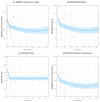Osteochondral Lesions of the Ankle Treated with Bone Marrow Concentrate with Hyaluronan and Fibrin: A Single-Centre Study
- PMID: 35203279
- PMCID: PMC8869915
- DOI: 10.3390/cells11040629
Osteochondral Lesions of the Ankle Treated with Bone Marrow Concentrate with Hyaluronan and Fibrin: A Single-Centre Study
Abstract
Osteochondral defects of the ankle (OCD) are being increasingly identified as a clinically significant consequence of injury to the ankle, with the potential to lead to osteoarthritis if left untreated. The aim of this retrospective cohort study was to evaluate a single-stage treatment of OCD, based on bone marrow aspirate (BMA) centrifuged to produce bone marrow concentrate (BMC). In a dual syringe, the concentrate was mixed with thrombin in one syringe, whereas hyaluronan and fibrinogen were mixed in a second syringe. The two mixtures were then injected and combined into the prepared defect. Clinical outcome and quality of life scores (MOXFQ and EQ-5D) were collected at baseline and yearly thereafter. Multilevel models were used to analyse the pattern of scores over time. Ninety-four patients were treated between 2015 and 2020. The means of each of the three components of the MOXFQ significantly improved between baseline and 1 year (p < 0.001 for each component), with no further change from year 1 to year 3. The EQ-5D index also improved significantly from baseline to 1 year, with no evidence for further change. Our results strongly indicate that this BMC treatment is safe for, and well tolerated by, patients with OCD of the ankle as both primary treatment and those who have failed primary treatment. This technique provides a safe, efficacious alternative to currently employed cartilage repair techniques, with favourable outcomes and a low complication rate at 36 months.
Keywords: ankle; articular cartilage; bone marrow concentrate; osteochondral defect; talus.
Conflict of interest statement
The authors declare no conflict of interest.
Figures



References
-
- Phemister D.B. The causes of and changes in loose bodies arising from the articular surface of the joint. J. Bone Jt. Surg. 1924;6:278–315.
Publication types
MeSH terms
Substances
Grants and funding
LinkOut - more resources
Full Text Sources

